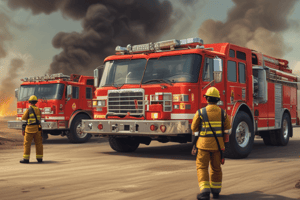Podcast
Questions and Answers
Define maritime terrorism according to the International Maritime Bureau and the Council for Security Cooperation in the Asia Pacific.
Define maritime terrorism according to the International Maritime Bureau and the Council for Security Cooperation in the Asia Pacific.
Maritime terrorism is defined by the International Maritime Bureau as any act of violence carried out by individuals on the sea with the intent or capability to use force. The Council for Security Cooperation in the Asia Pacific defines maritime terrorism as the undertaking of terrorist acts within the maritime environment using or against vessels or fixed platforms at sea or in the port, or against anyone of the passengers or personnel against coastal facilities or settlements.
What is the difference between maritime terrorism and piracy?
What is the difference between maritime terrorism and piracy?
Maritime terrorism and piracy both involve violent acts carried out by individuals on the sea. However, maritime terrorism is politically motivated and aims to achieve political goals, while piracy is driven by criminal activities and the intent to gain profit.
Discuss the challenges in preventing and dealing with maritime terrorism and piracy.
Discuss the challenges in preventing and dealing with maritime terrorism and piracy.
Preventing and dealing with maritime terrorism and piracy is challenging due to the overlap of characteristics between the two threats. The lack of definitional consensus further complicates the development of sound policies. Additionally, the perception of these threats varies among different states, making it difficult to establish effective prevention and response strategies.
What is the duty of states regarding torture?
What is the duty of states regarding torture?
What are the four categories of targets chosen by maritime terrorists?
What are the four categories of targets chosen by maritime terrorists?
What are the defining characteristics of maritime terrorism?
What are the defining characteristics of maritime terrorism?
What are the four conditions required for an act to qualify as torture?
What are the four conditions required for an act to qualify as torture?
What are some common methods of physical torture?
What are some common methods of physical torture?
What are some psychological forms of torture and ill-treatment?
What are some psychological forms of torture and ill-treatment?
Who are some frequent victims of torture?
Who are some frequent victims of torture?
Who are some potential offenders of torture?
Who are some potential offenders of torture?
Describe the importance of establishing an effective monitoring mechanism for persons in police custody.
Describe the importance of establishing an effective monitoring mechanism for persons in police custody.
What measures can be adopted to prevent, combat, and punish human trafficking, especially that of women and children?
What measures can be adopted to prevent, combat, and punish human trafficking, especially that of women and children?
Explain the significance of implementing legislation banning corporal punishment, particularly in schools and other welfare institutions for children, and establishing a monitoring mechanism for such facilities.
Explain the significance of implementing legislation banning corporal punishment, particularly in schools and other welfare institutions for children, and establishing a monitoring mechanism for such facilities.
Discuss the 10 duties of South Africa under CAT
Discuss the 10 duties of South Africa under CAT
Flashcards are hidden until you start studying




